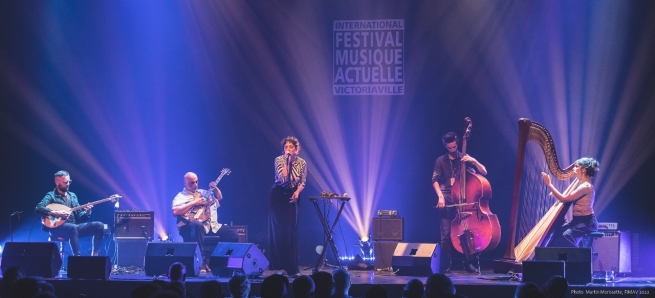
After a lean, socially distanced 2021 edition, Festival International de Musique Actuelle Victoriaville (FIMAV) returned this year with a strong program that offered concertgoers a chance to discover large-ensemble works by established artists along with fresh, genre-bending musical endeavours from the new generation.
The tone was set by the awe-inspiring performance of the Montreal-via-Cairo singer and composer Nadah El Shazly, whose intricate and truly unclassifiable songs blended twenty-first-century pop music and experimental electronic sounds, plus folk flourishes courtesy of Sam Shalabi’s oud and Radwan Ghazi Moumneh’s buzuk. El Shazly’s music offered enthralling melodies anchored by her group’s wall-of-sound approach, which made for a memorable set that highlighted her fantastic voice.
Drummer-singer Sean Noonan’s group Pavees Dance—which features American singer Malcolm Mooney (the original vocalist of the German experimental rock band Can) on vocals, Ava Mendoza on guitar, and Jamaaladeen Tacuma on electric bass—makes absurdist sci-fi avant-rock songs that owe a lot to Sun Ra and Captain Beefheart, with bandleader and charismatic oddball Noonan keeping everyone guessing. Mendoza also performed in William Parker’s Mayan Space Station, as did drummer extraordinaire Francisco Mela. Parker somehow managed to surprise even his diehard fans with an intense, tightknit, hour-long performance.

The unassuming supergroup Pangea de Futura— an alloy of experimental rock groups that includes Some Became Hollow Tubes, Black Givre, and BLD—presented dense drone rock pieces for brass, electronics, guitar, and three drummers, which would not be out of place on a bill with the music of Bohren & der Club of Gore.
This edition of FIMAV focused on improvised music, a highlight of which was the brilliant performance of Lebanon’s A Trio, who explored wildly creative extended techniques for trumpet, bass, and guitar in a minimalist, slow-paced fashion. The precision and vigour of their rambunctious soundmaking made this one of the most memorable FIMAV sets of the past decade. Similarly noisy, but with more maximalist tendencies, was Mopcut, who provided one of the loudest and most energetic sets of the week; leader Audrey Chen used extended techniques such as vocalise, screams, and grunts to accompany the thick slabs of electric sounds provided by her bandmates Julien Desprez and Lukas König. Neither a rock band nor a free-improv trio, Mopcut kept everyone on the edge of their seats. Legendary Japanese vocalist Koichi Makigami performed his first solo set at the festival and his passionate theatrical performance for voice and wind instruments was filled with humour. Bloodmist—a New York electroacoustic-ambient-improv trio of clarinet, electric bass, and drum machines—was, unfortunately, disappointing, offering a meandering set that never gained momentum.
While the FIMAV lineup had fewer saxophonists than usual, reedist Mats Gustafsson delivered two incredible sets: a duo with saxophonist Colin Stetson and a performance with his trio The Underflow, which includes singer-songwriter David Grubbs and trumpeter Rob Mazurek. Nobody expected minimalist nuance from the Stetson-Gustafsson duo, and many were therefore surprised by the beautiful melodies that emerged from their improvised set, an inspiring collaboration between two very different musicians. The Underflow’s performance offered engaging, dense sounds located somewhere on the outskirts of the experimental rock and jazz territories. Even more surprising for the trio was the inclusion of beautiful minimalist songs by David Grubbs, which Mazurek and Gustafsson backed gracefully. The trio set was a meeting of three different universes, yielding a strong iconoclastic result.
Three concerts were headlined by large ensembles. Vancouver’s Gordon Grdina presented new works for his Persian-music-influenced quartet The Marrow and his experimental jazz band Square Peg, with a finale featuring both ensembles. As performed by the inimitable Shahzad Ismaily on bass and synth, cellist Hank Roberts, and bassist Mark Helias, Grdina’s finely crafted compositions possessed uplifting qualities. Guitarist Mary Halvorson also performed in two separate groups, joining the Mivos Quartet and a jazz quintet, before forming a big band with both entities. Halvorson’s unique compositions were best served by the Mivos Quartet, with whom she delved into beautiful complex melodies that would occasionally tangle up with her signature tone-bending guitar leads. A full set with the Mivos Quartet would have most likely been more interesting than the more middle-of-the-road jazz quintet that accompanied her for the rest of the set. Unfortunately, the big band music presented that evening by Halvorson felt passionless and mostly fell flat when compared to the eventful experiments of the first set. René Lussier’s eight-piece ensemble Au Diable Vert was somewhat lacklustre (at least compared to his more daring past turns at FIMAV, playing with Martin Tétreault or Gros Mené), and mostly dabbled in fast-paced contemporary jazz with folk influences that, while complex, became repetitive and somewhat aimless.
Recent years have seen Victoriaville give more space to new-music composers to present recent works. Composer Simon Martin’s Musique d’art (2022) was presented in a church and benefitted from a jaw-dropping minimalist performance by a string quintet that patiently explored different harmonic juxtapositions. Also of great interest was the performance of Ida Toninato’s À travers le temps, entre les bruits by Montreal avant-garde ensemble No Hay Banda, who performed the piece with great restraint, building tension carefully with long, haunting tones. Montreal saxophone quartet Quasar presented compositions that mostly made use of the quartet’s saxophone acrobatics, which ended up making the experience somewhat tedious and predictable. On the other end of the spectrum, guitar quartet Dither turned what seemed to be a more academic musical program into a by-the-seat-of-your-pants trip; both Dither’s compositions and John Zorn’s game piece allowed the musicians to cut loose and explore unorthodox techniques and unrestrained soundmaking.
PHOTOS BY MARTIN MORISSETTE
Top photo, L-R: Sam Shalabi, Radwan Ghazi Moumneh, Nadah El Shazly, Jonah Fortune, Sarah Pagé.
Second photo, L-R: Pavees Dance members Malcolm Mooney and Ava Mendoza.
Third photo: Gordon Grdina and the members of Square Peg and The Marrow.
Bottom photo, L-R: Lyne Allard, Victor Fournelle-Blain, Jean René, Étienne Lafrance, Émilie Girard-Charest perform Simon Martin's Musique d'art.


